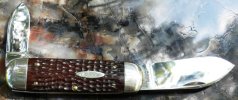waynorth
Dealer / Materials Provider
- Joined
- Nov 19, 2005
- Messages
- 33,351
Nice looking pen Vince, thanks for sharing. What strikes me about this one is how a basic knife with straight lines, symmetrical frame, two spear shaped blades, master and pen, can still come across so classy! Love the bone, color and jigging also.
Ken
Great pen knife. One of the nice things about the jigging is it is proportionate to the size of the knife.
Finer pattern on a finer knife.
Nice Southington, John. Ebony swell centers are a class act also!
















